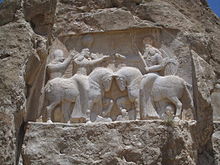
Ahura Mazda, also known as Oromasdes, Ohrmazd, Ahuramazda, Hourmazd, Hormazd, Hormaz and Hurmuz, is the creator deity in Zoroastrianism. He is the first and most frequently invoked spirit in the Yasna. The literal meaning of the word Ahura is "lord", and that of Mazda is "wisdom".

Hormizd-Ardashir, better known by his dynastic name of Hormizd I, was the third Sasanian King of Kings (shahanshah) of Iran, who ruled from May 270 to June 271. He was the third-born son of Shapur I, under whom he was governor-king of Armenia, and also took part in his father's wars against the Roman Empire. Hormizd I's brief time as ruler of Iran was largely uneventful. He built the city of Hormizd-Ardashir, which remains a major city today in Iran. He promoted the Zoroastrian priest Kartir to the rank of chief priest (mowbed) and gave the Manichaean prophet Mani permission to continue his preaching.

Hormizd II was king (shah) of the Sasanian Empire. He ruled for seven years and five months, from 303 to 309. He was a son and successor of Narseh.

Bahram I was the fourth Sasanian King of Kings of Iran from 271 to 274. He was the eldest son of Shapur I and succeeded his brother Hormizd I, who had reigned for a year.

Bahram IV, was the Sasanian King of Kings of Iran from 388 to 399. He was likely the son and successor of Shapur III.
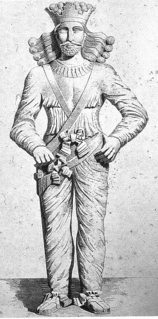
Shapur I was the second Sasanian King of Kings of Iran. The dating of his reign is disputed, but it is generally agreed that he ruled from 240 to 270, with his father Ardashir I as co-regent until the death of the latter in 242. During his co-regency, he helped his father with the conquest and destruction of the Arab city of Hatra, whose fall was facilitated, according to Islamic tradition, by the actions of his future wife al-Nadirah. Shapur also consolidated and expanded the empire of Ardashir I, waged war against the Roman Empire, and seized its cities of Nisibis and Carrhae while he was advancing as far as Roman Syria. Although he was defeated at the Battle of Resaena in 243 by Roman emperor Gordian III, he was the following year able to win the Battle of Misiche and force the new Roman Emperor Philip the Arab to sign a favorable peace treaty that was regarded by the Romans as "a most shameful treaty".

Ardashir II, was the Sasanian King of Kings of Iran from 379 to 383. He was the brother of his predecessor, Shapur II, under whom he had served as vassal king of Adiabene, where he fought alongside his brother against the Romans. Ardashir II was appointed as his brother's successor to rule interimly till the latter's son Shapur III reached adulthood. Ardashir II's short reign was largely uneventful, with the Sasanians unsuccessfully trying to maintain rule over Armenia.
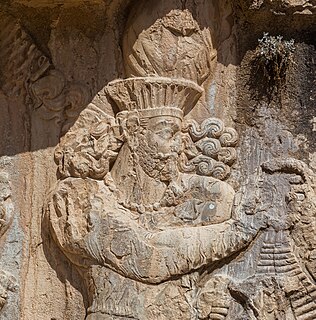
Narseh, "Great King of Armenia", was the seventh Sasanian King of Kings of Iran from 293 to 303.

Ardashir I, also known as Ardashir the Unifier, was the founder of the Sasanian Empire. He was also Ardashir V of the Kings of Persis, until he founded the new empire. After defeating the last Parthian shahanshah Artabanus IV on the Hormozdgan plain in 224, he overthrew the Parthian dynasty and established the Sasanian dynasty. Afterwards, Ardashir called himself "shahanshah" and began conquering the land that he called Iran.

Naqsh-e Rostam is an ancient archeological site and necropolis located about 12 km northwest of Persepolis, in Fars Province, Iran. A collection of ancient Iranian rock reliefs are cut into the face of the mountain and the mountain contains the final resting place of four Achaemenid kings notably king Darius the Great and his son, Xerxes. This site is of great significance to the history of Iran and to Iranians, as it contains various archeological sites carved into the rock wall through time for more than a millennium from the Elamites and Achaemenids to Sassanians. It lies a few hundred meters from Naqsh-e Rajab, with a further four Sassanid rock reliefs, three celebrating kings and one a high priest.

Artabanus IV, also known as Ardavan IV, incorrectly known in older scholarship as Artabanus V, was the last ruler of the Parthian Empire from c. 213 to 224. He was the younger son of Vologases V, who died in 208.

Taq-e Bostan is a site with a series of large rock reliefs from the era of the Sassanid Empire of Persia (Iran), carved around the 4th century CE.

The Sasanian or Sassanid Empire, officially known as the Empire of Iranians and also referred to by historians as the Neo-Persian Empire, was the last Iranian empire before the early Muslim conquests of the 7th–8th centuries CE. Named after the House of Sasan, it endured for over four centuries, from 224 to 651 CE, making it the longest-lived Persian imperial dynasty. The Sasanian Empire succeeded the Parthian Empire, and re-established the Persians as a major power in late antiquity alongside its neighbouring arch-rival, the Roman Empire.
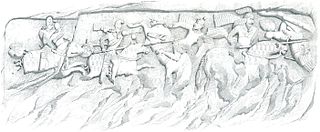
The Battle of Hormozdgan was the climactic battle between the Arsacid and the Sasanian dynasties that took place on April 28, 224. The Sasanian victory broke the power of the Parthian dynasty, effectively ending almost five centuries of Parthian rule in Iran, and marking the official start of the Sasanian era.
The modern Persian name of Iran (ایران) means "the land of Aryans". It derives immediately from the 3rd-century Sasanian Middle Persian ērān, where it initially meant "of the Iranians", but soon also acquired a geographical connotation in the sense of "(lands inhabited by) Iranians". In both geographic and demonymic senses, ērān is distinguished from its antonymic anērān, meaning "non-Iran(ian)".

Sasanian art, or Sassanid art, was produced under the Sasanian Empire which ruled from the 3rd to 7th centuries AD, before the Muslim conquest of Persia was completed around 651. In 224 AD, the last Parthian king was defeated by Ardashir I. The resulting Sasanian dynasty would last for four hundred years, ruling modern Iran, Iraq, and much territory to the east and north of modern Iran. At times the Levant, much of Anatolia and parts of Egypt and Arabia were under its control. It began a new era in Iran and Mesopotamia, which in many ways was built on Achaemenid traditions, including the art of the period. Nevertheless, there were also other influences on art of the period that came from as far as China and the Mediterranean.

Kartir, the great and influential Sasanian priest, has left an inscription in Naqsh-e Rajab in the Chamgan mountain. The inscription is located about one kilometer away from the south of ancient Istakhr city, and about three kilometers away from the north of Takht-e Jamshid. In Naqsh-e Rajab, there are also some figures of Ardashir I and Shapur I. Kartir's inscription is incised next to another inscription that shows Ahura Mazda appointing Ardashir I as the Shahanshah of Ērānshahr. Kartir is the only non-king person who was granted the right to have an inscription.

Shapur I's victory relief at Naqsh-e Rostam is located 3 kilometers north of Persepolis. It is the most impressive of eight Sasanian rock carvings cut into the cliff beneath the tombs of their Achaemenid predecessors.

The Coronation of Ardashir II is a rock relief that was carved between 379 and 383 by Ardashir II, the eleventh king of kings (shahanshah) of the Sasanian Empire. The rock relief is located in Taq-e Bostan in Iran.
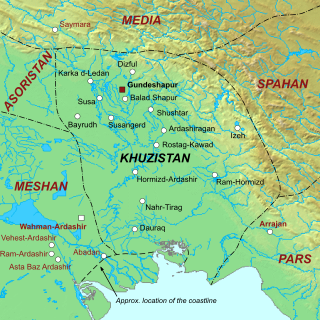
Khuzistan or Huzistan was a Sasanian province in Late Antiquity, which almost corresponded to the present-day province of Khuzestan. Its capital was Gundeshapur. During the late Sasanian era, the province was included in the southern quadrant (kust) of Nemroz.
